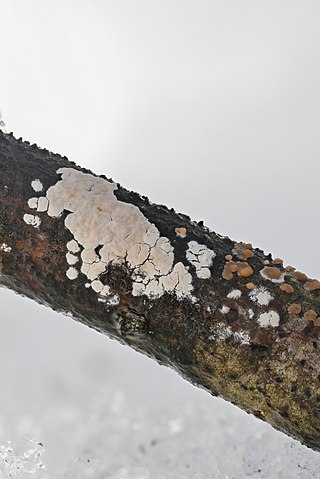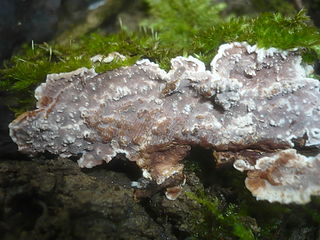
The Polyporales are an order of about 1800 species of fungi in the division Basidiomycota. The order includes some polypores as well as many corticioid fungi and a few agarics. Many species within the order are saprotrophic, most of them wood-rotters. Some genera, such as Ganoderma and Fomes, contain species that attack living tissues and then continue to degrade the wood of their dead hosts. Those of economic importance include several important pathogens of trees and a few species that cause damage by rotting structural timber. Some of the Polyporales are commercially cultivated and marketed for use as food items or in traditional Chinese medicine.

The Hymenochaetales are an order of fungi in the class Agaricomycetes. The order in its current sense is based on molecular research and not on any unifying morphological characteristics. According to one 2008 estimate, the Hymenochaetales contain around 600 species worldwide, mostly corticioid fungi and poroid fungi, but also including several clavarioid fungi and agarics. Species of economic importance include wood decay fungi in the genera Phellinus and Inonotus sensu lato, some of which may cause losses in forestry. Therapeutic properties are claimed for Inonotus obliquus ("chaga") and Phellinus linteus, both of which are now commercially marketed.

The Clavariaceae are a family of fungi in the order Agaricales. Originally the family contained most of the clavarioid fungi, but in its current sense is more restricted, albeit with a greater diversity of basidiocarp forms. Basidiocarps are variously clavarioid or agaricoid (mushroom-shaped), less commonly corticioid or hydnoid.

The Clavulinaceae are a family of fungi in the order Cantharellales. The family is not well defined, but currently comprises species of clavarioid fungi as well as some corticioid fungi. These species are nutritionally diverse, some being ectomycorrhizal, others wood-rotting saprotrophs, others lichenized, and yet others lichenicolous.

The Phanerochaetaceae are a family of mostly crust fungi in the order Polyporales.

The Auriculariales are an order of fungi in the class Agaricomycetes. Species within the order were formerly referred to the "heterobasidiomycetes" or "jelly fungi", since many have gelatinous basidiocarps that produce spores on septate basidia. Around 200 species are known worldwide, placed in six or more families, though the status of these families is currently uncertain. All species in the Auriculariales are believed to be saprotrophic, most growing on dead wood. Fruit bodies of several Auricularia species are cultivated for food on a commercial scale, especially in China.

The Auriculariaceae are a family of fungi in the order Auriculariales. Species within the family were formerly referred to the "heterobasidiomycetes" or "jelly fungi", since many have gelatinous basidiocarps that produce spores on septate basidia. Around 100 species are known worldwide. All are believed to be saprotrophic, most growing on dead wood. Fruit bodies of several Auricularia species are cultivated for food on a commercial scale, especially in China.

The Physalacriaceae are a family of fungi in the order Agaricales. Species in the family have a widespread distribution, ranging from the Arctic, (Rhizomarasmius), to the tropics, e.g. Gloiocephala, and from marine sites (Mycaureola) and fresh waters (Gloiocephala) to semiarid forests (Xerula).

Corticium is a genus of fungi in the family Corticiaceae. Basidiocarps are effused, corticioid, smooth, and grow on dead wood. One species, C. silviae, is lichenicolous. The genus was formerly used in a very wide sense for almost any effused corticioid fungi.

Phlebiopsis is a genus of poroid crust fungi in the family Phanerochaetaceae. The genus contains 11 species, which collectively have a widespread distribution. The genome sequence of the type species, Phlebiopsis gigantea, was published in 2014.
Australicium is a genus of corticioid fungi in the family Phanerochaetaceae. The genus was circumscribed by mycologists Kurt Hjortstam and Leif Ryvarden in 2002 to contain the type species, A. singulare, which is found in New Zealand. The Venezuelan species A. cylindrosporum was added to the genus in 2005.

The corticioid fungi are a group of fungi in the Basidiomycota typically having effused, smooth basidiocarps that are formed on the undersides of dead tree trunks or branches. They are sometimes colloquially called crust fungi or patch fungi. Originally such fungi were referred to the genus Corticium and subsequently to the family Corticiaceae, but it is now known that all corticioid species are not necessarily closely related. The fact that they look similar is an example of convergent evolution. Since they are often studied as a group, it is convenient to retain the informal (non-taxonomic) name of "corticioid fungi" and this term is frequently used in research papers and other texts.

The hydnoid fungi are a group of fungi in the Basidiomycota with basidiocarps producing spores on pendant, tooth-like or spine-like projections. They are colloquially called tooth fungi. Originally such fungi were referred to the genus Hydnum, but it is now known that not all hydnoid species are closely related.
Eichleriella is a genus of fungi in the order Auriculariales. Species produce effused or cupulate, waxy to leathery basidiocarps on wood, with a smooth to spiny surface. The genus currently contains more than 15 species.

Heteroradulum is a genus of fungi in the order Auriculariales. Species produce effused, leathery basidiocarps on wood, often pinkish red and partly or wholly covered in small sterile spines. The genus was originally published in 1917 by American mycologist Curtis Gates Lloyd under the facetious pseudonym "McGinty", rendering the name invalid. It was validated a century later to accommodate a group of species formerly placed in the genera Eichleriella or Heterochaete, but not closely related to either.

The Punctulariaceae are a family of fungi in the order Corticiales. The family in its current sense is based on molecular research and contains just three genera of corticioid fungi.
Colacogloea is a genus of fungi belonging to the class Microbotryomycetes. Most species in the genus are known only from their yeast states. Where known, basidiocarps have auricularioid basidia and occur as parasites on or in the fruit bodies of other fungi.
Adustochaete is a genus of fungi in the family Auriculariaceae. Species produce effused basidiocarps on wood, typically covered in small sterile spines or pegs. The genus was created as a result of molecular research, based on cladistic analysis of DNA sequences, to accommodate two species from Brazil and Mexico that are not closely related to the older and superficially similar genus Heterochaete. Two additional species, from Brazil and China, have since been described.
Proterochaete is a genus of fungi in the family Auriculariaceae. The type and only species, Proterochaete adusta, produces thin, effused, corticioid basidiocarps with a smooth or spiny surface on wood. The species was originally described from North America and is also known from northern Europe and Asia.
Sclerotrema is a genus of fungi in the family Auriculariaceae. The type and only species, Sclerotrema griseobrunnea, produces effused, corticioid basidiocarps on wood with a smooth surface. The species was originally described from Russia and is also known from Canada.













